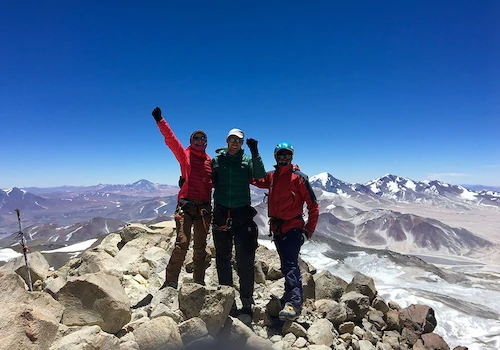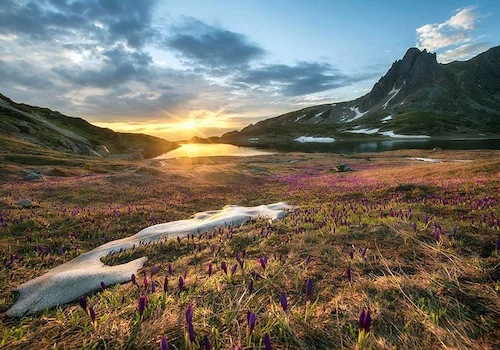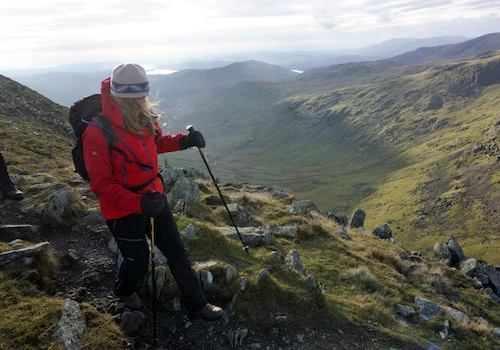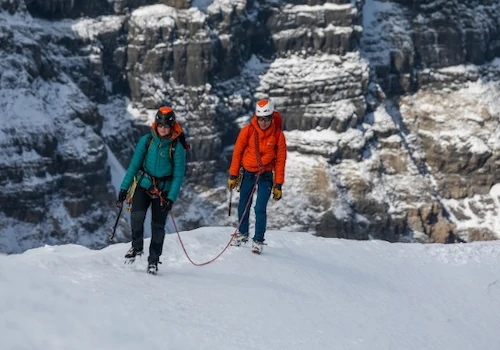
- Expeditions
By Region
By Month
By Grade
By Height

- Treks
- UK & Alpine
- Schools
- Hire
- News
- Shop
Bolivian Peaks Expedition
The Team: Owen Samuel (Team leader, Cumbria) Martin Barron (Dentist, Manchester) Paul Gwilliam (Computer Programmer, Wakefield) Hannah Vickers (Gap Year student, Cambridgeshire)
From Hannah: Why Bolivia? During the nine months since I’d booked onto the expedition, this question had been asked dozens of times by as many people, at the pre-expedition meets and by friends. My answer had to be i) the prospect of fine, dry and stable weather conditions ii) spending time mountaineering in several areas of the Cordillera Real and not just on one mountain and iii) the challenge posed by Illimani and Huayna Potosi, both at a greater altitude than what I’d been to on Mount Kilimanjaro and Mount Kenya, one and a half years previously.

The Team: Owen Samuel (Team leader, Cumbria) Martin Barron (Dentist, Manchester) Paul Gwilliam (Computer Programmer, Wakefield) Hannah Vickers (Gap Year student, Cambridgeshire)
From Hannah: Why Bolivia? During the nine months since I’d booked onto the expedition, this question had been asked dozens of times by as many people, at the pre-expedition meets and by friends. My answer had to be i) the prospect of fine, dry and stable weather conditions ii) spending time mountaineering in several areas of the Cordillera Real and not just on one mountain and iii) the challenge posed by Illimani and Huayna Potosi, both at a greater altitude than what I’d been to on Mount Kilimanjaro and Mount Kenya, one and a half years previously.
My preparation for the expedition began in October 2002, and I made the pre-expedition meets a priority. I found them not only a chance to meet up with fellow expedition members but also a great opportunity to walk and climb with like-minded people and talk to others who had been on past expeditions and were now booked on another! By the time the magic date of 25 June arrived, I was very excited and eager to get into the mountains. But, because we were flying into La Paz airport, at just over 4000m above sea level, a few days of acclimatising was needed for our bodies to adjust to the lower atmospheric pressure and oxygen available. When we landed in La Paz, the altitude was felt by us all immediately; even drinking a bit of water left me feeling like I’d just sprinted a 100m race!
We spent a day in La Paz, making final preparations for a week in the Condoriri area and an ascent of Huayna Potosi (6088m) before we would be returning to the hotel again. La Paz itself literally flows down the whole valley – all the buildings converge from the valley slopes down into the bottom of the valley. The drive from the airport down to our hotel in central La Paz (a height drop of some 400m) was truly memorable – Illimani was just visible on the skyline and towered above the whole city, just as the sun was beginning to rise.
On our second day we travelled for about 3 hours, along part of Lake Titicaca’s perimeter to get to the rather delightful little town of Copacabana where we stayed for 2 nights. Walking along the streets for the first time in a pair of shorts, Martin hadn’t quite realised how cold it was despite the strong sun – but after trudging through some melted snow he soon realised! We discovered some great places to eat out and where to buy funky-looking hats (and matching socks too, in Paul’s case) and on our second day we spent a day on Isla del Sol (Island of the Sun) and walked along from the north to south end of the island. It was a relaxing but windy 2-hour boat ride from Copacabana across Lake Titicaca. The weather every day had been beautiful, with lots of sunshine and clear skies, just as I’d hoped and imagined. What better way to acclimatise?
The next part of the expedition took us to Tuni at 4300m with our cook, Domingo and his assistant Mario. Although the journey was approximately 4 hours long, the time seemed to pass very quickly, we were so preoccupied with the amazing mountain scenery appearing before us. Here we spent an unexpectedly cold night camping amongst strange noises from the mules and llamas close by. It was definitely an amusing experience.after some morning entertainment watching our rather temperamental llamas being loaded up with kit bags, we began our trek in to the Condoriri base camp, at 4650m, beside the shores of Laguna Chiar Khota. As quoted by the guidebook, the peaks were indeed “truly fairylike” and we were fortunate enough to be camping here with only a few other climbers. The campsite was reportedly very busy at times, with up to 100 tents!
During our week here, we climbed a number of peaks – Point Austria; (about 5200m, estimated using an altimeter) a straightforward walk over rock and scree with fantastic views from its summit, Pequeño Alpamayo; an ascent which I personally can’t describe due to being ill when the rest of the team climbed it, Mirador; another rocky peak involving some easy but tiring scrambling and Pirimide Blanca, a pyramidal snow and rock peak accessed by a glacier with sections of hard icy snow at 45-50º up to a col and a short scramble in crampons close to the summit. And if you are in the mood for a bit of ice climbing on hard water ice, there’s an ice-covered crag beside the glacier where you can climb at Scottish Grade IV/ V. Be warned though – at this altitude it’s still exhausting and one pitch was sufficient for me!
Leaving the Condoriri and our acclimatisation period was quite a sad occasion, but it was time to move on to our first big mountain Huayna Potosi (6088m). It was a mountain we’d viewed from every peak we’d climbed in the Condoriri and had been very impressed by. Back in Tuni, we were picked up by jeep and driven straight to our first campsite on the mountain near the Zongo dam, situated in a rather bleak and uninspiring mining area. Our first impressions weren’t particularly positive, especially after sleeping on a campsite surrounded by beautiful peaks in the Condoriri but inside the refuge where we had a supper of soup, steak and vegetables, we listened to a bit of Sophie Ellis-Bextor music on the CD player tucked away in the corner of the dining area. Add to this some artificial lighting and a warm, cosy atmosphere and our thoughts of the area soon changed dramatically!
In the morning we made the 2-hour ascent up to the high camp on the rock ridge, (Campamento Rocas) about 200m lower than Campamento Argentino, which was on the glacier (our cooks weren’t keen on camping here). It was quite a windy little spot but very convenient, with the glacier directly next to it. With a very early summit day, waking up at 2am ahead, most of us were in our sleeping bags by 6pm. The night was quite dynamic, with high-speed winds and the outer sheets of our tents flapping about but fortunately it had died down when we departed from camp at 3am. Despite the very low temperatures and lights from our head torches I felt very close to shutting my eyes and drifting back to sleep as we trudged up the glacier in the dark. In the distance were the bright lights of La Paz, which brought on thoughts of a comfortable hotel bed, hot showers and clean clothes..after a ladder climb over a crevasse though, the time seemed to pass relatively quickly and there was only a short time till the sun would be rising! Once at the base of the head wall, a 250m snow/ ice slope at 45-50º we had sunshine on our backs, which provided some long-awaited warmth. Graded alpine AD-, we used two axes. It wasn’t particularly technical, but exhausting enough for me to need dozens of “breathers” due to the altitude we were climbing at. Finally, we all arrived at the summit at 6088m above sea level at 9am and collapsed in a heap beside Owen, who understandably had a bemused expression on his face. We realised that several teams must have turned around when it was still dark, as we were surprised to see only 3 other people on the summit with us (and no one behind); a Bolivian guide and German couple. The scenery was absolutely breathtaking – northwest we could see across to the Condoriri, now a cluster of tiny jagged peaks and at the opposite end, far into the distance was Illimani. We just about succeeded in squeezing together for a summit photo, then picked ourselves up for the descent.
After being lowered down the head wall, the delights of La Paz were back on our minds again and we made a huge effort to hoof it down to the high camp and get packed away. Luckily our porters were still waiting for us when we plodded in at midday and Domingo had also cooked some lunch, which we sat down to eat before beginning to pack. The walk from high camp to the Zongo dam refuge seemed remarkably longer than the previous day but in fact took only an hour, and we were picked up by jeep at 4.30pm. It was an hour’s drive into El Alto, and should have been only a short drive from there to the hotel, but due to vehicle restriction rules which operate in the city – allowing only vehicles with certain registration plates on certain days, our jeep driver had to quite tactfully blag a permit from one of the traffic wardens to get us back to the hotel. It was very amusing to sit back and observe!
We spent 2 nights in La Paz, using the day before the journey to Illimani to rest and write postcards. It was also Paul’s birthday on our rest day, and we went out in the evening to celebrate. Not satisfied with the beers in our first restaurant, the three blokes decided we would head back to a restaurant called Angelo Colonial’s and have some beer there till 10pm.
In the morning, we left the hotel at 8am and our jeep trip to Pinaya took us through the rather spectacular Cañon de Palca, a deep vertical gorge of fascinating rock features and then up the mountainside where the roads weaved round on narrow ledges like you wouldn’t imagine..with drops to the side of thousands of feet and no rails to prevent vehicles from going over the edge, it was no wonder that a few of us felt a teensy bit anxious when looking out the window! Being a less accessible mountain than Huayna Potosi, I think we all appreciated the beauty and excitement of the jeep drive to a greater extent, travelling up from the valley bottom in Cañon de Palca to Pinaya at 3800m above sea level. Decorated with eucalyptus trees and small farms, the land use was very similar to that of Isla del Sol.
A 2-hour steady trek in strong sun took us to Illimani base camp at Puente Roto at 4400m. From here we could just discern the next days’ route up to the Nido de Condores high camp at 5450m (Condor’s nest) and our summit day from there to Pico Sur (south peak) at 6439m. Unfortunately Martin suffered from vomiting and diarrhoea during the afternoon and evening, the second occasion during the trip and it was uncertain whether he would be well enough to make the ascent to high camp in the morning. As things turned out, he was feeling too weak by breakfast time the next morning and decided to remain at base camp whilst Owen, Paul and myself went on up to Nido de Condores. Mario also joined us to cook our supper in the evening!
We experienced a wide variety of ground, from grass to ice-covered rocky streams, narrow sandy ledges and scree slopes before even reaching halfway! After spending some 45 minutes for lunch at a col, we moved onto the main part of the rock ridge with easy scrambling on slate in places, and up some rock slabs that were coated in fine scree in others – a bit slippery underfoot. Nevertheless it was an enjoyable climb to camp, which we reached at 2.30pm. The rest of the afternoon was spent resting in preparation for the long summit day in the morning. We ate boil-in-the-bag meals with pasta for dinner – I wasn’t sure what to expect of them at first but I thought they were actually quite good.
Our summit day began at 4am and I was somewhat reluctant to get out of my nice warm sleeping bag as usual, but both Paul and Owen were as lively and enthusiastic as ever. We left camp as planned, by 5am and moved straight onto the glacier beside the camp. The first snow ridge was well equipped with fixed snow stakes, which saved us carrying dozens of them. This was also the same ridge that 6 Chileans had been killed on, whilst descending the mountain in 1989. It was a very cold, slow ascent to the snow platform at around 5800m, but we reached here at sunrise and everywhere below us seemed so peaceful. Meanwhile, the ground ahead was increasingly icy, but not too steep. As usual I needed to pause frequently for breathers, which I’m sure were now becoming a bit frustrating for Owen and Paul; when Paul started calling for stops things didn’t seem quite right.on the second occasion he was retching and had a banging headache. It was apparent that the altitude had hit him and ironically, we were at 6000m, just lower than Huayna Potosi which he’d summitted a few days earlier without any problems. We eventually dug out a snow hole for him, and Owen fished out a bothy bag for him to sit and wait in while Owen and I continued to the summit. Fortunately for Paul, the sunshine had touched the glacier, now about 9am, and it provided some warmth.
Feeling tired I somehow wished it was me sitting down and enjoying the sunshine, sheltered from the wind as well but I was more determined now to make it to the top of Pico Sur – still another 400m of height to gain. As the angle of the slope increased and the snow became harder and icier, it was necessary to front-point our crampons and ice axe for about 50m. There was a further 20-30m of 50º slope to cross a bergschrund but beyond this was just a long, tiring pull up to the crest of the summit ridge, with a couple of crevasses to avoid falling into along the way! We’d been ascending from the west – it was extremely windy, enough to sting my face but as soon as we crossed onto the east side it all disappeared and the air was much warmer and calmer, a pleasant change. From the false summit there was about a further 100m to walk along an exposed ridge to the true summit and we reached here at midday, exactly 7 hours from the high camp. It was a great feeling, quite tempting to relax but we’d be needing a lot more concentration for the descent. After spending only enough time to take photos and grin all I wanted (from feeling very pleased of course) we left the summit, thin layer of cloud and the biting wind to find a calmer spot to sit down at and have something to drink and eat.
We picked Paul up from his snow hole about ½ hour later, he was still feeling rough, so getting down as soon as we safely could was important. Back down at the snow platform at about 5800m, we took off a layer or two of clothing and roped up using a rather ingenious system which Owen had devised for descending the final ridge into camp. We all felt safe and secure on this section and arrived back at Nido de Condores just after 3.30pm. Paul was keen to continue to Puente Roto, understandably, but I was too shattered to face another 2 hours of descending over terrain that was tricky in places so Mario, Paul and the two porters we’d hired left will all the kit, except our tent and the cooking equipment while Owen and I spent another long night at Nido de Condores. We’d finished dinner by 6pm and retired to our much-valued sleeping bags soon after. Fourteen hours and a hot drink later, we packed up and left the camp. The wind was strong and bitterly cold, and the sun wasn’t due to reach the ridge until after 9am so we didn’t want to hang about much, just get moving and warmed up.
Back at Puente Roto at 10.30am, we were warmly greeted and congratulated by Domingo. Our last day here was spent generally chilling out, just what was needed after a gruelling few days on the mountain. Our jeep turned up about 10 minutes after we’d walked back into Pinaya the following day, a great surprise really because we were not expecting it for at least another 2 hours later! A slight mishap due to a landslide in the road ahead of us meant that we had to turn back and take a different route, however we returned to La Paz at about 3.15pm and ate out with Domingo and Mario in the evening as a thank you gesture. It was also an enjoyable way to reflect on the past 3 weeks of the expedition – all the experiences we’d had, jokes we’d shared (usually relating to each other’s awful habits!!!) and memories of all the amazing mountainous landscape we’d seen.
What more can I add? As our expedition drew to a close, I was already hatching plans to return to this great country.
Hannah Vickers, 3 August 2003





